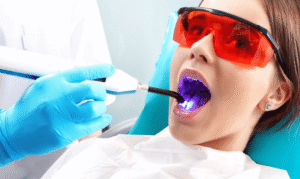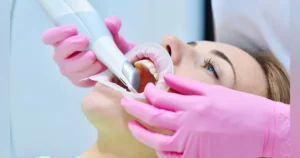Modern dentistry uses advanced dental imaging technology to achieve precision, clarity, and efficiency that traditional diagnostic methods cannot achieve. Dental care has evolved and is increasingly dependent on technology for diagnosis, treatment, and monitoring. Professionals can use digital X-rays, CBCT, and 3D imaging to deliver more accurate and successful treatments. These advances improve clinical efficiency and patient outcomes by providing comprehensive insights into the oral cavity, teeth, and tissue structures.
Understanding the Transition from Traditional to Digital Imaging
Traditional dental imaging uses film-based X-rays that require chemical processing and manual storage. While these systems are effective, there are still issues with clarity, timing, and radiation exposure. Digital imaging has changed this technology. Digital X-rays are instantly viewable, deliver less radiation, and can process images for better diagnosis. This change allows dentists to identify problems early, streamline treatment plans, and share data with specialists and insurance companies. Digitization also allows for better tracking and comparison of data.
Impact of Cone Beam CT
One of the biggest advances in dental imaging is cone beam computed tomography (CBCT). It creates a 3D scan of the patient’s oral and maxillofacial anatomy. Unlike two-dimensional X-rays, CBCT scans allow dentists to accurately analyze bone density, nerve pathways, sinus cavities, and tooth root locations in three dimensions. CBCT is essential for implant design, root canal treatment, orthodontics, and assessing the condition of the jawbone. The data allows dentists to plan treatments more accurately and predictably.
The Value of 3D Imaging in Treatment Planning
Dentistry is able to develop 3D oral models that go beyond CBCT using intraoral scanners and digital imprinting devices. These models can be used to design crowns, bridges, and orthodontics. Dentists can use 3D imaging to simulate treatment outcomes and determine the best treatment plan for the patient. The improved visibility can reveal microcracks, hidden disease, and atypical root structures that are not detected with 2D imaging. This level of information can improve care and the patient experience.
Improved Patient Safety and Reduced Radiation
Advanced dental imaging has significantly reduced radiation exposure. Traditional X-ray and imaging equipment uses more radiation than digital equipment. This makes taking pictures safer for patients, especially those who require follow-up exams. Children, pregnant women, and medically vulnerable populations benefit greatly from these developments. Dentists can now take high-quality pictures while also monitoring the safety of their patients. By storing and viewing images digitally, preservation becomes more effective because repeated exposure is avoided.
Improved Diagnosis and Early Detection
Advanced imaging techniques can help detect dental problems early. Early detection of cavities, cysts, tumors, bone loss, and gum disease enables effective treatment. This could improve treatment outcomes and reduce dental costs and invasiveness. Detailed imaging can reveal trauma, infection, or unexplained symptoms that are not visible during standard clinical evaluation. Advanced imaging techniques can aid in early diagnosis and preservation of teeth and surrounding structures.
Enhance Patient Education and Communication
Dental imaging can help physicians and educate patients. High-resolution dental photographs help patients better understand their diagnosis and develop a treatment plan. Digital images on the screen during a consultation can simplify complex issues. Patients value openness and participation in decision-making. This visual aid can increase trust and adherence to preventive and post-treatment care.
Optimize and Collaborate Dental Workflows
Advanced imaging technology streamlines dental office productivity and improves collaboration between specialists. General dentists, orthodontists, periodontists, and oral surgeons can quickly share digital files. This method of communication provides all patient care professionals with the same, accurate data, resulting in more consistent and efficient treatment plans. Digital impressions enable laboratories and manufacturers to create restorations more quickly and accurately, minimizing turnaround time and errors. Modern, efficient dental practices use digital images.
Applications in Restorative and Cosmetic Dentistry
Both cosmetic and restorative dentistry benefit from advanced dental imaging. Digital imaging allows patients undergoing smile makeovers to see the results of veneers, crowns, and teeth whitening. Dentists fabricate these restorations to look and function naturally. Digital scanning allows dental implants and crowns to be placed precisely, improving fit and comfort. This technology enhances aesthetic treatments, giving patients greater confidence and better results with fewer adjustments and follow-up treatments.
Applying Artificial Intelligence to Image Interpretation
The analysis and interpretation of dental scans is supported by artificial intelligence. Artificial intelligence software can accurately detect tooth decay, bone loss, and other problems. This technology can act as a second pair of eyes, helping professionals make faster and more informed decisions. By mapping changes in oral health over time, AI can help assess risk. Dentists can use artificial intelligence (AI) and digital imaging to increase diagnostic accuracy, reduce errors, and improve treatment planning, especially in busy clinics.
Modern Dental Education, Training and Accessibility
As imaging technology advances, dental schools and continuing education programs are emphasizing digital diagnostics. Standard courses include operating modern equipment and interpreting 3D scans. This prepares future dentists to use these tools from the start. At the same time, we are taking steps to make this technology more accessible to clinics with limited access to care and smaller practices. Advanced imaging techniques are becoming standard in many dental practices as costs decrease and awareness increases.
Conclusion
Advanced dental imaging is essential to modern dentistry. These technologies have revolutionized dental diagnosis, planning, and treatment. Digital imaging tools are transforming dental care by improving patient safety, comfort, clinical accuracy, and efficiency. They improve communication, early detection, and the accuracy and accessibility of dental care. As technology advances, advanced imaging techniques are becoming increasingly important in modern dentistry.
FAQs
1. What is advanced dental imaging?
Using digital X-rays, 3D scans, and cone beam computed tomography, detailed images of the teeth, jaws, and oral tissues are created for diagnosis and treatment.
2. Why is digital imaging better than X-rays?
Digital imaging is faster, more accurate, and uses less radiation. Images can be enhanced, stored, and shared effortlessly.
3. Advanced dental imaging: is it safe for patients?
Yes, most advanced imaging systems use much less radiation than traditional x-rays. This makes them safer and more suitable for daily use.
4. Can advanced imaging technologies detect problems earlier?
Absolutely. CBCT and 3D scanning can detect abnormalities in the teeth before symptoms occur, allowing for rapid treatment.
5. Are most dental practices equipped with advanced imaging equipment?
As equipment becomes more affordable and training more accessible, many modern dental practices are using these technologies.




